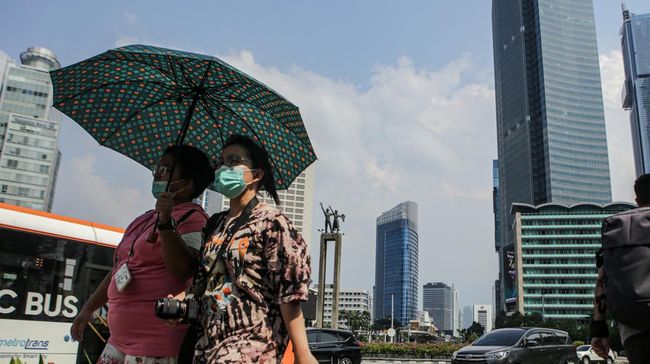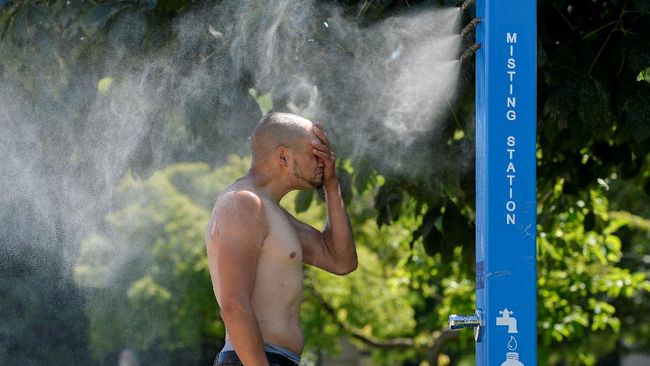FACT CHECK
Indonesian CNN
Monday, May 15, 2023 11:21 AM WIB
Jakarta, CNN Indonesia —
Chain messages in a circulating chat app claiming that all of Indonesia will be hit by a heatwave. Expert also talk about the real facts.
Previously, a number of countries in South and Southeast Asia, such as Bangladesh, Myanmar, India, China, Thailand, Laos and Vietnam, were affected by the heat wave phenomenon or Heat wave, since the beginning of this month.
This phenomenon broke many local maximum temperature records. Following this news, RI was also affected by rumors that he had been affected by a heat wave.
Deni Septiadi, a senior lecturer at the Meteorology, Climatology and Geophysics Agency (STMKG) College of Meteorology, said the chain post was accompanied by a temperature map of the Asian region, which is mainly red-black with the title “Heat wave in Asia”.
“Please inform the group, up to their respective families, that the weather is warming up. The drink should be more than usual. And pay more attention to the risk of fire, do not use candles without control, make sure the stove turns off after use. We protect our family and friends. Submit this information now. I hope it is useful“, says the message, it is not known who started it.
Deni explained that the chain messages claiming to be from the Global Deterministic Prediction System, Environment and Climate Change Canada, were hoaxes. One of them is due to the temperature card not being read correctly.
“The on-chain message that extreme heat is hitting Indonesia is a hoax,” he said in an analysis received CNNIndonesia.comSunday (14/5).
He said the display of the global air temperature map did indeed come from Canadian authorities. “However, the card is not read correctly,” he said.
Deni explained that on the map, people will see red in the Indonesian Maritime Mainland (BMI) region like Thailand with a temperature of 40 degrees Celsius.
In fact, if you look closely at the map, the red color on the BMI has a figure of 20 to 30 degrees Celsius.
“That means it’s completely normal for tropical regions where incoming solar radiation tends to be perpendicular,” he said.
“Even at the equator (Pontianak, West Kalimantan) the sun is at zero (equinox) twice a year, namely between March 20-21 and September 22-23,” he added.
According to him, the reason why the air temperature seems warmer at this time has more to do with the position of the sun.
According to him, in the March-April-May (MAM) phase, seen from the movement of the sun’s position (north-south), the current fluid flow pattern begins to be dominated by Australia which tends to be dry. .
“As a result, the chances of rain for most migrant workers will be lower (although this does not mean months without rain) compared to the December-January-February (DJF) phase.”
In the MAM phase, cloud growth and rain will also be dominated by convective processes thermal.
“Air transport will be maximized in this way, in addition to convergence (especially in coastal areas) and orography (in mountainous areas,” he said.
“Therefore, for perfect cloud microphysics with an updraft capable of carrying water vapor and producing a phase change (condensation), it takes longer than the DJF phase.”
“Generally we will be warm for 2-3 days before the clouds are perfect to produce precipitation or rain,” he added.
Also, according to BMKG data, Deni said there were no temperature anomalies in Sumatra, Java, Kalimantan, Sulawesi, Kupang, NTB, Maluku regions of Papua.
The highest BMI daily maximum temperatures in the past 3 years also occurred mostly in 2021 and not 2023.
Not a hot zone
Does this mean Indonesia is safe from heat waves?
Deni said that Indonesia is not a region usually affected by this phenomenon. This is because the archipelago is not an area that forms high pressures.
He explained that heat waves form due to high pressure systems over a large area. It then seems to form a blanket that traps the hot air coming out of the affected area.
“The system will prevent rainfall from occurring in affected areas,” he said.
“However, IMC is not an area or an area that forms high pressure, so physically heat waves cannot occur in Indonesia,” he explained.
Regarding the possibility of heat due to exposure to ultraviolet rays, Deni also denied this. He said that UV is electromagnetic radiation with a wavelength shorter than visible light, but longer than X-rays.
“Therefore, UV is not directly related to air temperature, even though the radiation exposure distribution map also shows a red to purple color gradation like air temperature,” said he declared.
(lom/arh)

“Travel nerd. Social media evangelist. Zombie junkie. Total creator. Avid webaholic. Friend of animals everywhere. Future teen idol.”


:strip_icc():format(jpeg)/kly-media-production/medias/3387188/original/007486800_1614303448-banner__1_.jpg)



